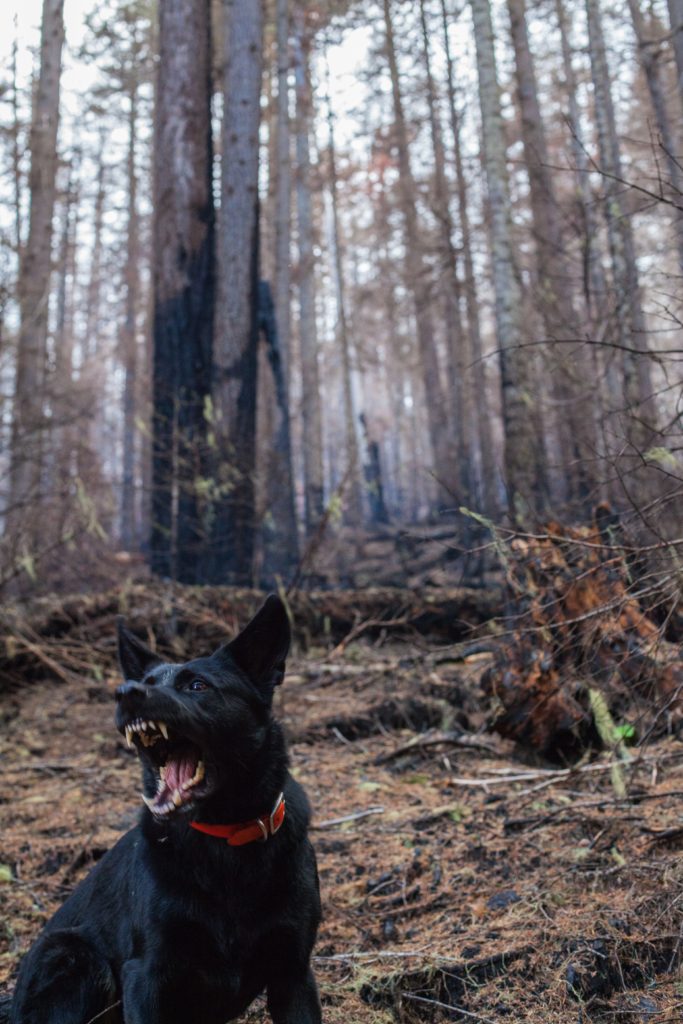Have you ever said something like:
Treats won’t work if he’s barking.
Nothing works when he sees another dog!
She won’t pay attention to me when she’s like that.
If you have, then this post is for you!
Before we get started and I explain what the heck “mountain lion brain” means, we first need to define one term: threshold. “Threshold” refers to that line in the sand where underneath the line your animal is “okay” and over the line they go into fight-or-flight mode. This is an overly simplistic view (for a more in-depth discussion as to types of thresholds check out this article) and there are more options over threshold than just fight or flight, but for our purposes in this post this definition will suffice. Essentially, under threshold can look like this:

While over threshold can look like this:

Or this:

Or even this! (I mentioned there are more options than fight or flight; freeze is another option.)

Understanding thresholds and what your particular animal’s body language looks like below and above threshold is imperative to successfully working with them, especially for those working on fear, anxiety, reactivity, and aggression. One of the reasons for this is that learning– or at least the type of learning that we typically think of with training– does not happen over threshold. This is another overly simplistic and inaccurate statement for the true science pros in the audience, but it’s true from the eyes of the average pet owner. This is why your dog won’t take treats or sit when he’s reactive. It’s why nothing works at that moment.
I call this over-threshold state, “Mountain Lion Brain”. You have willingly come to this webpage and are hopefully comfortable and able to absorb the material. However, if you were being chased by a mountain lion and I ran up alongside you and asked if you’d like to learn about your pet’s behavior, the answer is no! You couldn’t possibly learn while you’re being chased by a mountain lion. You have “Mountain Lion Brain”.
That over-threshold state is not conducive to learning for you or your pet. Your pet is not stubborn, or stupid, or has selective hearing when they’re over threshold. When they’re experiencing “Mountain Lion Brain”, the fear/strong emotions center of their brain takes over and essentially shuts down the learning and reasoning parts of their brain (overly simplistic but you get the picture). They’re not learning because they can’t.
Sometimes when I explain this, a client will ask me, “But he’s not actually in danger. Why does he still have “Mountain Lion Brain”?” A good question! Threats are not always physical and they’re not always “real” from an outsider’s perspective. For example, public speaking is one of the top fears of people across the world. There is no actual, physical threat in public speaking (unless maybe you’re a prominent and controversial figure). The threat is not “real” from an outsider’s perspective, however, can feel very real to the person who fears public speaking. At the end of the day, it doesn’t matter if someone else perceives the threat as “real” or valid; it only matters if the individual experiencing it perceives it as such. Fear doesn’t always make sense.
What Should I do if my Pet is Experiencing “Mountain Lion Brain”?
The best answer is to remove the threat and/or your pet from that situation. A note: many pets will “redirect” their frustration or fear onto the closest being when they have “Mountain Lion Brain”. This is why many dogs bite their owners for grabbing their collars when they’re reactive. It’s safer to remove the threat instead of your pet. If that’s not possible, please do so with caution and by physically handling them the least amount possible.
There’s no sense in trying to train if your pet is not going to be able to learn. Make a mental note of your pet’s body language leading up to threshold, what the involved triggers were, and anything else of consequence so that you can avoid those situations in the future. Your behavior consultant will be able to help you make a plan to work on behavior concerns under threshold, where both you and your pet will be safer and more successful.
Now what?
- Learn your pet’s body language approaching threshold. This step is so important that we give it to almost every client as one of their first homework tasks. This helps to make your pet’s behavior more predictable to you.
- Identify triggers based on your pet’s body language. Additionally, identify if your pet is able to learn, respond to you, and eat when you see certain signals. That lets you know how close they are to “Mountain Lion Brain” and gives you information as to whether this is a training moment or a management moment.
- Find management solutions to keep your pet under threshold. Get creative!
- For additional help with body language, management, and other foundation skills, check out our Setting Yourself up for Success: Behavior Modification Basics course.
- Contact your behavior consultant to help you with any of the above and to come up with a solution to working on your pet’s behavior concerns under threshold. If you aren’t yet working with a behavior consultant, contact us at [email protected] to work with someone from our team!
Happy training!
Allie
